![]()
![]()
![]()
Use LEFT and RIGHT arrow keys to navigate between flashcards;
Use UP and DOWN arrow keys to flip the card;
H to show hint;
A reads text to speech;
96 Cards in this Set
- Front
- Back
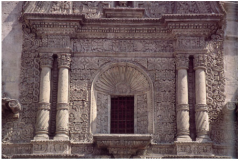
|
Example of mestizo style: Façade of the Church of Santiago. |
|
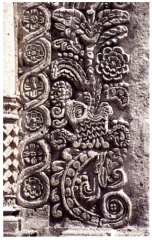
|
DETAIL OF:
Example of mestizo style: Façade of the Church of Santiago.
|
|
|
In depth example of how the Church of Santiago (Peru) is an example of Mestizo Style... |
Use of volcanic rock, porous stone. Decorative style for the sculptured decoration in churches. Used planimetricsm. Ex of EUROPEAN form: use of columns, double arches, scrolls within patterns, and the use of flowers. Ex of NATIVE form: figures of indigenous people with headdresses, the patterns look like the patterns on a tunic for a spa inca. |
|
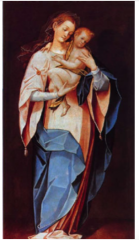
|
Virgin and Child Bernardo Bitti (Italian artist) Colonial Period (late 16th/early 17th Cent.) Oil on canvas, Church of Santiago
EXAMPLE OF MANNERISM |
|
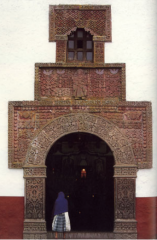
|
Example of tequitqui style: Façade of Church of Santiago
16th Cent., Angahuan, Viceroyalty of New Spain (Michoacán, Mexico) |
|
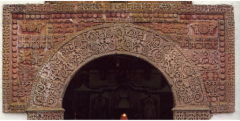
|
DETAIL OF:
Example of tequitqui style: Façade of Church of Santiago
16th Cent., Angahuan, Viceroyalty of New Spain (Michoacán, Mexico) |
|
|
Mestizo/a |
Spanish term denoting a person of mixed parentage, of a Spaniard and a native indigenous person. |
|
|
Mestizo Style |
A style of architectural decoration (in 17th-18th c.) in southern Highland Peru. It combines Baroque forms with images of local flora & fauna, as well as Andean sacred symbolism. |
|
|
Tequitqui Style |
A nahuatl term for 'vasal' used by art historians to denote a style of architectural carving in early colonial New Spain that flat with deep bevelled carvings and different decorative elements tend to be placed next to each other rather than made to interconnect. |
|
|
Transculturation |
The change in a culture brought about by the diffusion within it of aspects from other cultures. Cultural change viewed as a two-way process involving appropriation and interchange. The idea that neither group is the same ever again. They both change each other. |
|
|
Acculturation |
A change in the cultural behavior and thinking of a people through contact with another culture. Culture change viewed as integration of one culture into another. The idea that a dominant group came in and enforced their ideas to the lesser/subordinate group, and that lesser group couldn't do anything about it. |
|
|
Planimetricism |
The flattening of 3-D form. Very dense (thick) patterns that covers a wide surface area. The patterns give off a shadow effect which can be viewed as outlines. The outlining flattens the image. |
|
|
Mannerism |
The use of elongated proportions and highly stylized poses. |
|
|
When did European Conquest of Latin America occur? How did European powers divide the region? |
-1521 (Mexico & Central America) and 1534 (South America -Into Spanish colonies called Viceroyalties |
|
|
LEARN How does Bailey define the mestizo and tequitqui styles? Which façade listed above is said to be in the mestizo style? The tequitqui style? What characterizes these styles? |
-mestizo & tequitqui: difference b/w is the region. mestizo for peru and tequitqui is for new spain. planimetricism (flattening of 3d forms). blending of european architectural traits and symbols with native ones. motifs arranged in grid-like pattern (native approach). very dense patterning.
|
|
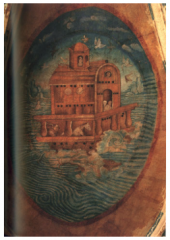
|
Noah's Ark Juan Gerson Colonial Period (16th Cent.) Pigment on papel de amate, Church of Tecamachalco, Viceroyalty of New Spain (Mexico)
EXAMPLE OF NATURALISM & JUXTAPOSITION |
|
|
In depth example of how Noah's Ark piece is an example of Naturalism & Juxaposition... |
Naturalism -Light & shadow rendering on the boat -Linear perspective used on boat -Details: Hair in horse's mane and waves in ocean
Juxtaposition -Holy War Symbol: atl-tlachinolli (FIRE/WATER) |
|
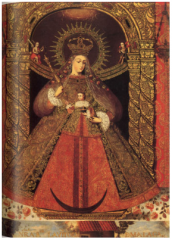
|
Our Lady of the Victory of Malaga Luis Niño Colonial Period (18th Cent.) Oil on canvas, Viceroyalty of Peru
EXAMPLE OF CONVERGENCE |
|
|
In depth example of how Our Lady of the Victory of Malaga piece is an example of Convergence... |
-Half Circle/moon crescent ~Virgin standing on moon crescent for Europeans = Virgin of the Apocalypse ~Tumi knife for Natives = Earth Goddess ~Red = royalty/Sapa Inca ~Flowers were used in sacrificial rights ~Golden scepter = Mama Ollco -Virgin Mary =/or Pachamama |
|

|
The Virgin Mary of the Cerro Rico of Potosí Colonial Period (18th Cent.) Oil on canvas, Viceroyalty of La Plata
EXAMPLE OF SYNCRETISM |
|
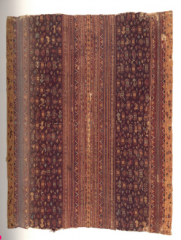
|
Lliclla (woman's tunic) Colonial Period (early 16th to 17th Cent.) cotton and wool |
|
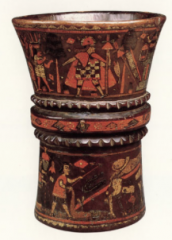
|
Kero (cup) Colonial Period (late 17th to 18th Cent.) wood and pigment inlay |
|
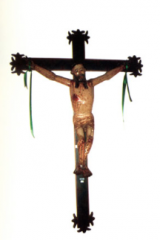
|
Crucifix Colonial Period (16th Cent.) polychrome pasta de caña de maíz (corn stem paste) |
|
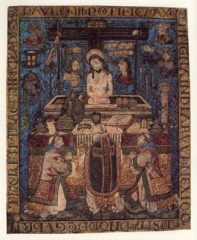
|
The Miraculous Mass of St. Gregory Colonial Period (16th Cent.) feather on wood |
|
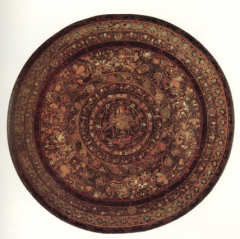
|
Batea (laquer tray) Colonial Period (17th Cent.) inlaid lacquer wood |
|
|
Juxtaposition |
2 different visual elements or visual practices to convey distinct meaning. Ex: Noah's Ark |
|
|
Convergence |
2 distinct meanings in one visual element. Ex: Luis Nino, Our Lady of the Victory of Malaga |
|
|
Syncretism |
2 distinct meanings unite/combine into one visual element to create new meaning. Ex: The Virgin Mary of the Cerro Rico of Potosí |
|
|
Naturalism |
Attempts to achieve the nature of the subject through use of light and shadow, linear perspective and detail. Ex: Noah's Ark - 3D & use of detail |
|
|
LEARN Bailey discusses some of the terms that have been used "to describe what happens to symbols from two cultures when they interact" (88). How does he differentiate between the following terms: juxtaposition, convergence, and syncretism? Consider these terms in relation to the following colonial paintings. |
J: fire/water native symbol (aztec glyph) with naturalism (european style of represent things realistically) C: two different MEANINGS converge causing different interpretations in the same image. crescent moon = virgin mary. tumi knife = pacha mama S: pacha mama and the virgin mary are both embodied in the same figure together (not one or the other). mountainous shape describes pacha mama. interpreted as ONE single female figure that lived the life of Mary and pacha mama herself. |
|
|
In Noah's Ark, Gerson juxtaposes 2 different ways of representing objects/concepts. Explain. |
European style of describing water + aztec indigenous symbol for fire/water in that water. European naturalism painting aesthetic plus aztec writing symbols. |
|
|
In Our Lady of the Victory of Malaga, the half-circle shape and by extension the figure at the center have dual meanings; in other words, different meanings converge. Explain. |
Virgin Mary. Red color = inca royalty representation. Black crescent = new moon that virgin mary stands on or a tumi knife |
|
|
In the Virgin Mary of the Cerro Rico of Potosí, the meaning of figure at the center could be said to be syncretic. Explain. |
natives might have interpreted the figure as a divine being w/the attributes of both the virgin mary and pacha mama. Mountain represents pacha mama and the figure is literally shaped like a mountain. |
|
|
What Pre-columbian media and production techniques continued to be used by viceregal and church authorities and social elites during the colonial period? |
textiles & corn? |
|

|
Mexico City Biombo depicting bird's-eye view of Mexico City Colonial Period (17th Cent.) oil on canvas |
|

|
Plaza Mayor Plaza Mayor of Mexico City 1596 ink on paper |
|
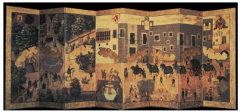
|
View of the Viceregal Palace in Mexico City Features classicizing façade, Viceroyalty of New Spain mid 17th Cent. image on a biombo |
|
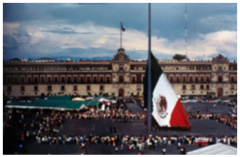
|
Claudio de Arciniega and others, Viceregal Palace Mexico City Colonial Period (16th-17th Cent.) |
|
|
Council of the Indies |
A council based in Spain that dictated how the colonies would function, even including the layout of the cities/colonies/viceroyalties |
|
|
Renaissance Classicism (Classical, Classicizing) |
An approach to aesthetics that favors restraint, rationality, and the use of strict forms. |
|
|
Triumphal Arch |
A monumental structure pierced by at least one lofty and typically arched passageway and usually commemorating a notable victory, person, or event. |
|
|
Biombo |
Room divider/screen |
|
|
Architectural orders |
Tthe ancient styles of classical architecture, each distinguished by its proportions and characteristic profiles and details, and most readily recognizable by the type of column employed. |
|
|
Doric order |
One of the three orders of ancient Greek or classical architecture |
|
|
Grid plan |
The urban planning guide the council of the Indies for the Viceroys to follow. The streets would run parallel and perpendicular to each other in a grid-like form with the Plaza in the center as a perfect square. |
|
|
Sebastiano Serlio |
Architect of the 15th c. Italian Renaissance the believed in the importance of the grid-like structure, symmetry, harmony and balance |
|
|
Vitruvius |
Architect of the 1st c. Ancient Rome = 2 main roads and 1 main plaza |
|
|
Leon Battista Alberti |
An Italian humanist author, artist, architect, poet, priest, linguist, philosopher and cryptographer; he epitomised the Renaissance Man. |
|
|
King Philip II |
King of Spain |
|
|
Laws of the Indies |
Issued in 1573 by King Philip II and the council of the Indies in Madrid, Spain. Simplicity in style is their way of saying “we understand the basics of what is important in culture”. |
|
|
Rusticated walls |
Usually squared off but left with a more or less rough outer surface and wide joints that emphasize the edges of each block. |
|
|
Guild |
An organization of persons with related interests, goals, etc., especially one formed for mutual aid or protection. |
|
|
Claudio de Arciniega |
Spanish architect and sculptor. He designed the Mexico City Metropolitan Cathedral |
|
|
LEARN What were the characteristic features of Mexico City's urban plan during the colonial period? How did this urban layout come about? Explain how this layout followed from and reinforced European philosophical notions, the colonialist social hierarchy, and notions of power. |
mexico city in colonial period: characterized: has a grid structure with a perfect square at the center to promote harmony and balance. cathedral of our lady and viceregal palace. come about: classicizing urban plan. old texts describing renaissance ideas of best urban layout. social order. logic and reason. check notes for more on the texts part. notions: logic reason harmony balance SIGNIFICANCE = classical/classicizing aesthetic: sign of high civilization |
|
|
LEARN What were some of the architectural features of the Viceregal Palace when it was first built in the 16th century? What impressions was the structure meant to convey? How was the Viceregal Palace later modified? |
features: spanish coat of arms used to show viceroy is close to the king and has a lot of power. made to be simple in design. long, low blocks to build it. plain windows. two clock towers to appear fortress-like. 2 stories long and low. basic geometric shapes to show logic and reason. arestocating walls (clean straight edges but front facade is left rough) impressions: reason and logic. austerity. classicizing |
|
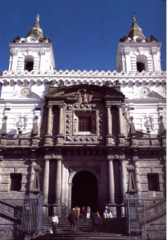
|
Church of San Francisco (Front Façade) Quito, Viceroyalty of New Granada (Ecuador) colonial period c. 1586 (16th Cent.)
EXAMPLE OF CLASSICIZING |
|
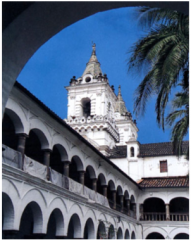
|
Church of San Francisco (Main Cloister) Quito, Viceroyalty of New Granada (Ecuador) colonial period c. 1586 (16th Cent.)
EXAMPLE OF CLASSICIZING |
|
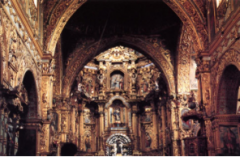
|
Church of San Francisco (Interior) Estaban Guzmán and others Quito, Viceroyalty of New Granada (Ecuador) colonial period 1769 (18th Cent.)
EXAMPLE OF BAROQUE |
|
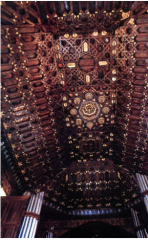
|
Church of San Francisco (Mudéjar wood ceiling over the choir) Quito, Viceroyalty of New Granada (Ecuador)
|
|
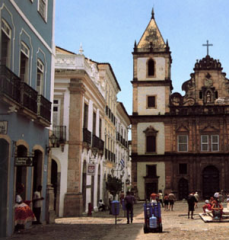
|
Church of São Francisco (Front Façade) Salvador, Viceroyalty of Brazil (Brazil) colonial period 1686-1737 (late 17th-early 18th c.)
EXAMPLE OF ROCOCO |
|
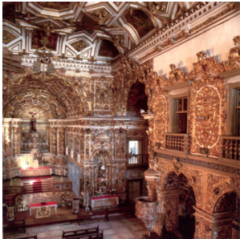
|
Church of São Francisco (Interior) Friar Luis de Jesus (sculptor) and others Salvador, Viceroyalty of Brazil (Brazil) colonial period 1686-1737 (late 17th-early 18th c.)
EXAMPLE OF ROCOCO |
|
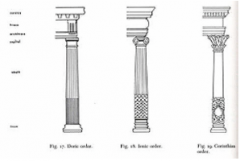
|
Drawing of Architectural Orders |
|
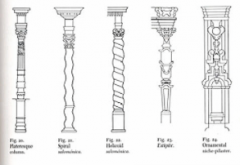
|
Drawing of Columnar and Pilaster forms of Spain and Mexico 16th to 18th centuries |
|
|
Classicizing Style |
Refers either to the art produced in antiquity or to later art inspired by that of antiquity |
|
|
Doric Column |
They have a capital made of a circle topped by a square. The shaft is plain and has 20 sides. There is no base in the Doric order. |
|
|
Ionic Column |
The most thin and small columns out of the three canonic orders. The Ionic capital is characterized by the use of volutes. The Ionic columns normally stand on a base which separates the shaft of the column from the stylobate or platform |
|
|
Baroque Period/Style |
Relating to or denoting a style of European architecture, music, and art of the 17th and 18th centuries that followed mannerism and is characterized by ornate detail. |
|
|
Rococo Style |
Characterized by an elaborately ornamental late baroque style of decoration prevalent in 18th-century Continental Europe, with asymmetrical patterns involving motifs and scrollwork. |
|
|
Retablo |
A devotional painting, especially a small popular or folk art one using iconography derived from traditional Catholic church art. |
|
|
Gold Leaf |
Gold that has been hammered into thin sheets by goldbeating and is often used for gilding. |
|
|
Mudéjar Style |
The Mudéjar style, a symbiosis of techniques and ways of understanding architecture resulting from Muslim and Christian cultures living side by side, emerged as an architectural style in the 12th century on the Iberian peninsula. It is characterised by the use of brick as the main material. |
|
|
LEARN Bailey writes that "the most splendid Renaissance exterior in South America" is that of the Church of San Francisco in Quito, Ecuador. What characterizes its style? What effects were intended? Explain in detail. |
exterior: doric columns on bottom and ionic columns on top. morality. concave convex staircase speaks to harmony and order and balance. strength and power of triumphal arch. diamond point decoration. ratable facade. 2 story arcade. |
|
|
LEARN Bailey points out that this church "also happens to have one of the continent's most exuberant Baroque interiors." What characterizes the style of the interior? What effects were intended? Explain in detail |
interior: gold leaf used excessively to create dramatic looks with lights and shadows throughout the day. elaborate ornamentation in every single bit of space. naturalistic elements in sculpture and painting. over choir has spanish mudejar ceiling. |
|
|
LEARN What is the style of the exterior and interior architecture of the Church of São Francisco in Salvador, Brazil? What characterizes this style? What effects were intended? Explain in detail. |
rococo: a lot of ornamentation but is more playful and delicate than baroque. is lighter because it lets white stucco show through between gold leaf. lace-like effect. symmetry like baroque. |
|
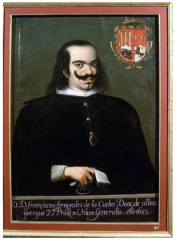
|
Don Francisco Fernández de la Cueva (8th Duke of Albuquerque, 22nd Viceroy) Anonymous 1653 Oil on canvas |
|

|
Virgin of Guadalupe with Apparitions José Juarez workshop 1656 Oil on canvas |
|
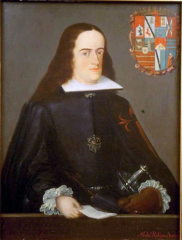
|
Don Francisco Fernández de la Cueva Enríquez (10th Duke of Albuquerque, 34th Viceroy) Nicolás Rodríguez Juárez 1708 Oil on canvas |
|
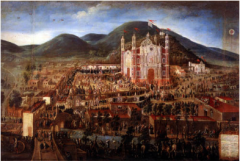
|
Translation of the Image and Inauguration of the Shrine of Guadalupe Manuel Arellano ca. 1709 Oil on canvas |
|
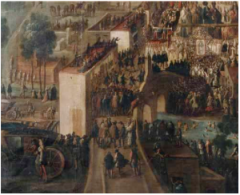
|
Translation of the Image and Inauguration of the Shrine of Guadalupe (Detail) Manuel Arellano |
|
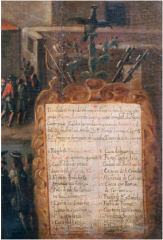
|
Translation of the Image and Inauguration of the Shrine of Guadalupe (Detail showing legend) Manuel Arellano |
|

|
Translation of the Image and Inauguration of the Shrine of Guadalupe (Detail showing the new sanctuary) Manuel Arellano |
|
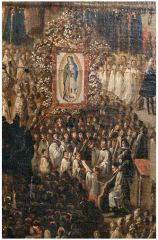
|
Translation of the Image and Inauguration of the Shrine of Guadalupe (Detail with Guadalupe icon, altar, and musical ensemble) Manuel Arellano |
|
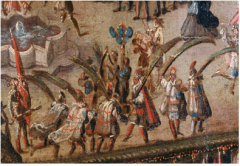
|
Translation of the Image and Inauguration of the Shrine of Guadalupe (Detail showing legend) Manuel Arellano |
|
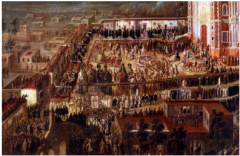
|
Translation of the Image and Inauguration of the Shrine of Guadalupe (Detail of central plaza) Manuel Arellano |
|
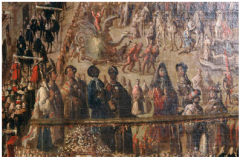
|
Translation of the Image and Inauguration of the Shrine of Guadalupe (Detail of central plaza w/inventions) Manuel Arellano |
|
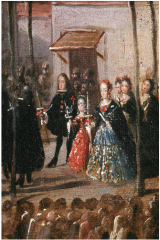
|
Translation of the Image and Inauguration of the Shrine of Guadalupe (Detail of Viceroy Albuquerque, his daughter & wife) Manuel Arellano |
|
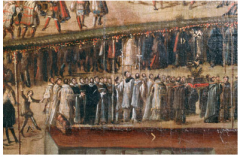
|
Translation of the Image and Inauguration of the Shrine of Guadalupe (Detail of procession and prancing young man) Manuel Arellano |
|
|
LEARN What is depicted in Transfer of the Image and Inauguration of the Shrine of Guadalupe? What purposes did the painting serve during the rule of Viceroy of Francisco Fernández de la Cueva Enríquez (1702 to 1711, the 10th Duke of Albuquerque)? |
purpose: benefits viceroy by creating legendary reminder of his rule. makes him seem political, religious, and noble and verifies all these qualities. church elite benefit by emphasizing virgin of guadalupe image and they get the new basilica. Criollos benefit because it verifies religion roots in the americas mestizos and natives benefit by their status is established |
|
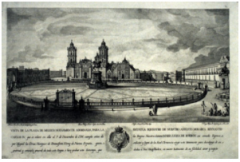
|
View of the Plaza Mayor of Mexico City José Joaquín FABREGAT 1797 engraving (after a drawing by Rafael JIMENO Y PLANES) |
|
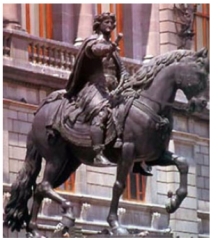
|
Equestrian Portrait of Charles IV (el caballito) Manuel TOLSA 1803 originally located in Plaza Mayor, Mexico City Bronze |
|
|
Neoclassical (Neoclassicism) |
Refers to the art produced later but inspired by antiquity |
|
|
Soffit |
describes the underside of any construction element. Examples of soffits include: the underside of an arch |
|
|
Zócalo |
The main plaza of Mexico City. It was the main ceremonial center in the Aztec city of Tenochtitlan and from the colonial period on, the main plaza or square in the heart of the historic center of Mexico City. |
|
|
According to Dawn Ades, why were art academies created in Latin America? What social, political, economic and cultural purposes did they serve? |
r |
|
|
Who created the Royal Academy of San Carlos of New Spain? When and why? What motivations did local officials have? What aesthetic style did the Academy promote during this period? |
r |
|
|
Of what significance was Tolsa's Equestrian Portrait of Charles IV? When, how, and why was it produced? Where was it originally located? What were the subject matter and themes of the monument? What artistic style does the monument exemplify, and what characterized this style? How was the monument meant to function? What was the ultimate fate of the monument? |
neoclassical style. image of spanish king charles IV. manuel TOLSÁ the royal academy of san carlos of new spain - mexico city viceroyalty of new spain (1st art academy in the western hemisphere) charles III made the academy happen neoclassical style meant to counter excesses of baroque style. motivations of viceregal authorities: practical needs strenghten commerce demonstrate good taste neoclassical style: natural pose and gesture. attention to detail, surface detail and texture, true to scale and proportions |

